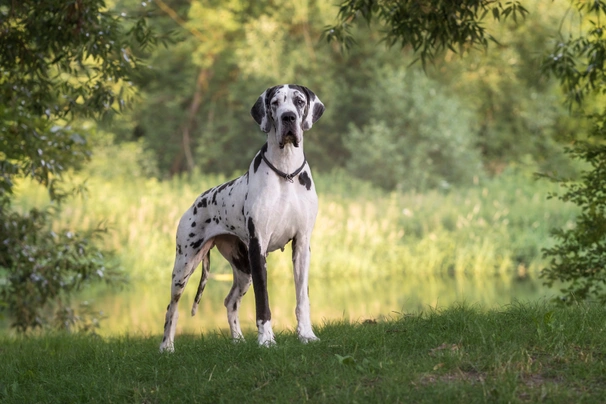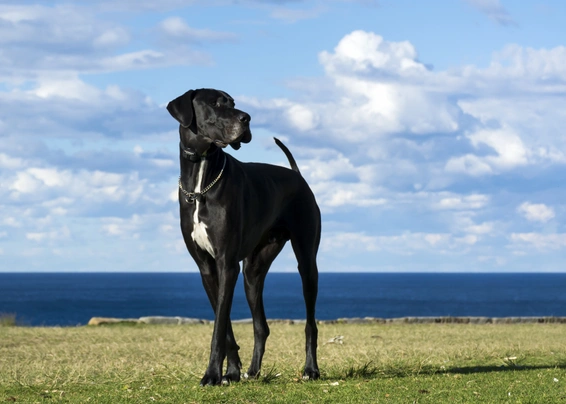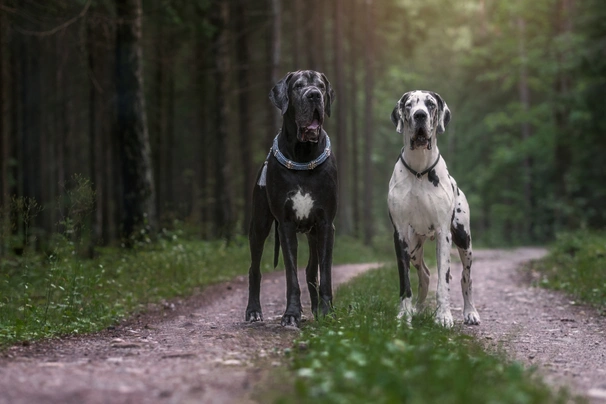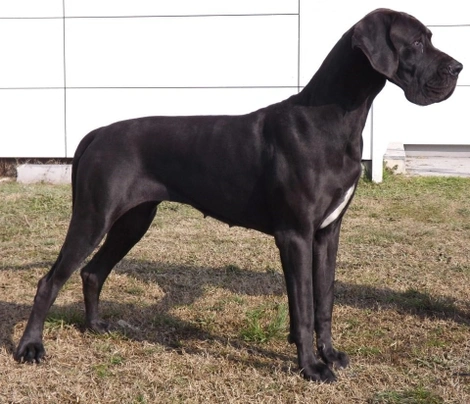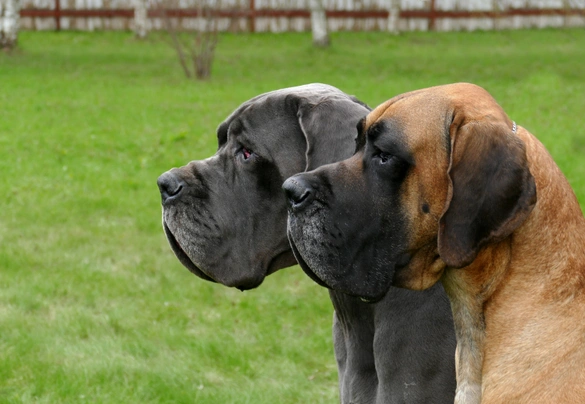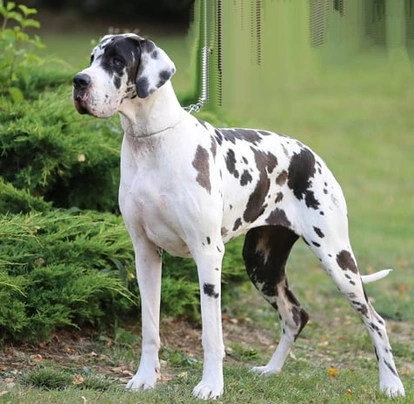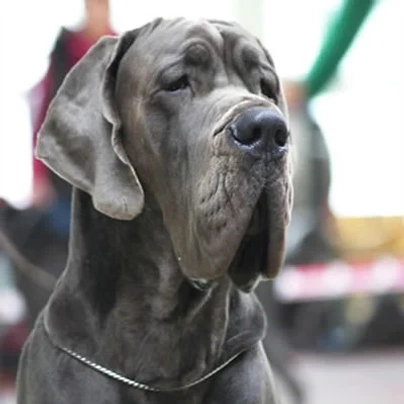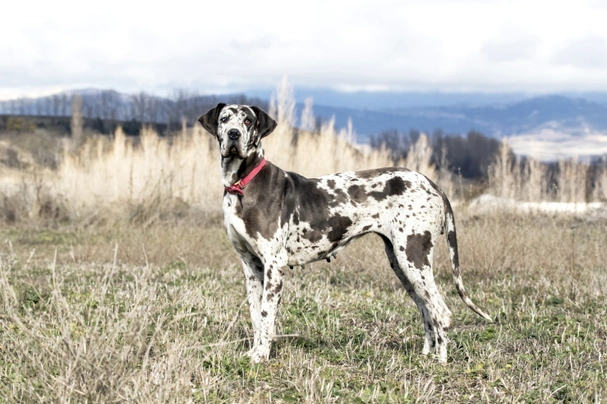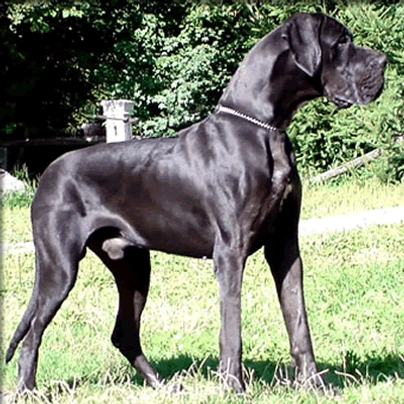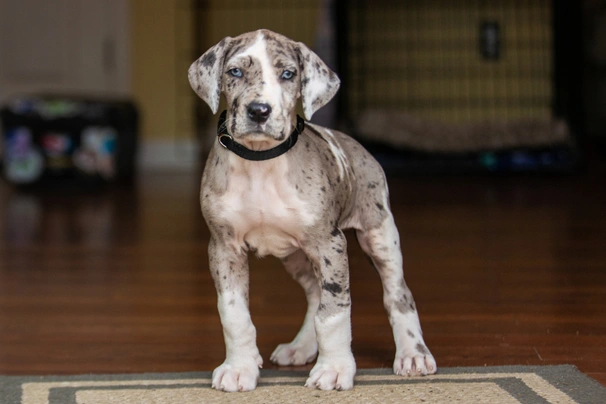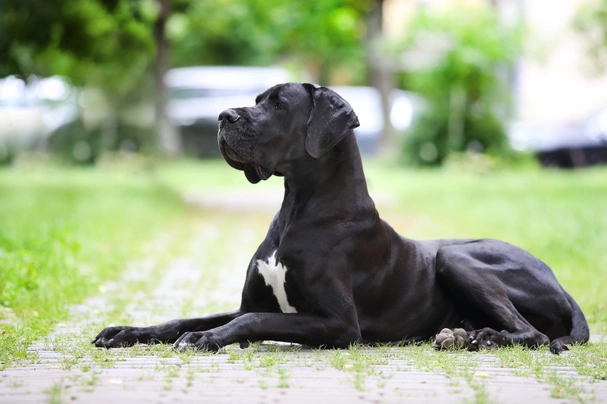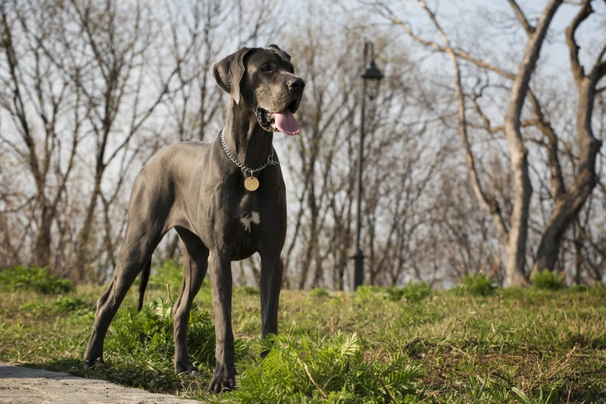Great Dane
Pros
Cons
Introduction of the Great Dane
The Great Dane may be a large dog but they are true gentle giants and as such they have become a popular choice both as family pets and companion dogs not only in the UK but elsewhere in the world too. They boast very kind playful natures and seem to have an affinity with children of all ages. Their devotion and loyalty to their owners matches a Great Dane's impressive looks.
Great Danes are a noble dignified breed but for such large dogs they can be quick off the mark when the occasion arises and they love nothing more than to be part of a family and being involved in everything that goes on in a household. Great Danes being one of the larger breeds sadly have quite a short life span and they are known to suffer from a few health issues but with this said the pros far outweigh any cons about the breed which is why they have consistently remained such a popular breed.
History of the Great Dane
The history of the Great Dane can be traced all the way back to Ancient Egypt with images of similar looking dog being found on monuments that date back to 3000 BC. Artifacts found in Babylonian temples and images of ancient Assyrian people with large dogs that resemble the Great Dane from 2000 BC. There are those who believe that dogs resembling the breed could well have originated in Tibet and there is a striking similarity between Great Danes and Tibetan Mastiffs with early records of the dogs being found in Chinese writings that date back to 1121 BC.
It is thought that Assyrian traders sold their dogs to Romans and to the people of Ancient Greece. The Romans took up the gauntlet and began breeding these dogs to other dogs they had found in Britain. As such it is thought that both English and Tibetan Mastiffs are in the breed's ancestry. There are those who also think that other breeds namely the Irish Greyhound and the Irish Wolfhound may well have been used to develop the breed over time with the Comte de Buffon a French naturalist in the 1700's believed the Irish Wolfhound was the main ancestor of the Great Dane. He based his theory on the fact that both the English and the Romans took large dogs with them which they crossed to the Irish Wolfhound.
The debate however continued with the Baron Cuview believing that the breeds responsible for creating the Great Dane were in fact the Irish Wolfhound and the English Mastiff with the earliest crossed having been called "Boar Hounds" because they were used to hunt wild boar. It was during the 16th Century that these dogs were called English Dogges. By the end of the 16th Century German aristocracy and noblemen bred large hunting dogs which were known as Kammerbunde which translated means "Chamber Dogs" because they were kept inside rather than in kennels outside.
It was the Comte de Buffon who named the breed the "Great Dane" after having travelled through Denmark where he spotted similar looking dogs to the Boar Hound that were slimmer much like the Greyhound. He thought it was because of the Danish weather that the dogs had changed in appearance and decided to call them the Grand Danois which then became the Great Danish Dog with heavier dogs being called Danish Mastiffs.
The "Dane" side of the breed's name stuck even though the Great Dane was not developed in any way whatsoever in Denmark. Breed enthusiasts all agree that these handsome statuesque dogs were developed in Germany having been imported by noblemen during the 17th and 18th Century. By the end of the 18th Century it was decided that the dogs found in Germany were vastly different to the heavier dogs found in Britain namely the English Mastiff and as such they decided to call them the German Dog or Deutsche Dogge. The Deutsche Doggen Club of Germany was then established.
However other European countries did not take to the breed being called Deutsche Dogge with the Italians calling the breed the "Alano" even to this day. In other parts of the world the breed is known as the Great Dane with their first appearance in the UK being in 1877 when they became a very popular choice with owners of large estates where they continued to be used to hunt game by nobility. In 1885 the first breed club was established in the UK and from then onwards these proud and noble dogs have become a popular choice as family pets and companions all thanks to their wonderfully loyal friendly natures and stunning looks.
Interesting facts about the breed
- Is the Great Dane a vulnerable breed? No they are among some of the most popular dogs in the UK
- Similar dogs were around in Ancient Egyptian and Roman times
- Noblemen prized them so much they kept Great Danes in their Great Halls rather than in kennels outside
- Great Danes are extremely large dogs but they are renowned for being “gentle giants”
- They were originally bred to be guard and hunting dogs and more especially to hunt wild boar
- Although they have “Dane” in their breed name they do not originate from Denmark
- The dog in Scooby Doo is a Great Dane
- A Great Dane called Zeus holds the record for being the tallest dog standing at 44 inches at the wither
Appearance of the Great Dane
Height at the withers: Males 76 - 81 cm Females 71 - 76 cm
Average weight: Males 54 - 62 kg Females 46 - 54 kg
There is no doubt that Great Danes are among the most impressive looking dogs on the planet. Their size disguises the fact they boast kind and gentle natures. Their heads and jaws alone are large and show just how powerful these dogs are when they need to be. They boast having broad muzzles and well chiseled faces with long forefaces and very wide bridges to their noses which is a typical characteristic of the breed.
Their nostrils are large and open which adds a blunt appearance to their nose and their lips hang slightly at the front. Eyes are deep set and medium in size being dark in colour although dogs with harlequin coats can have either wall or odd coloured eyes which is permissible. Ears are triangular and moderate in size being set high on a dog's head and they fold forward without being too pendulous.
A Great Dane's jaw is strong and dogs boast a perfect scissor bite where their upper teeth neatly overlap their lower ones. They have long necks that dogs carry well arched. When Great Danes take a proud stance their heads and necks are very well defined. Shoulders are well developed and muscular without being too loaded and they slope well back. Their front legs are perfectly straight showing lots of bone.
They boast a deep brisket with well sprung ribs and their belly is well drawn up. Their back is strong with loins being slightly arched. A Great Dane's hindquarters are extremely well developed and muscular showing that these dogs have a tremendous amount of power when needed. Back legs are powerful and well-muscled and their feet are very cat-like with dogs boasting well arched toes and strong curved nails that are dark in colour with the exception being in harlequin dogs when their nails are lighter in colour which is permissible as a breed standard. Their tail is thicker at the root but it tapers to the tip which dogs carry level to their backs and slightly curved when they are on the move.
When it comes to coat the Great Dane boasts a short thick coat that is sleek to the touch and not rough feeling at all. The accept breed colours for Kennel Club registration are as follows:
- Black
- Blue
- Brindle
- Fawn
- Harlequin
- Mantle (Black Body with white on Muzzle Collar and Chest)
Great Danes with brindle coats have a lighter buff to deep orange ground colour with black stripes.
Fawn coats can be a light buff right through to a deep orange with darker shades around a Great Dane's head and ears which is allowed under the KC breed standard
Blue coats can range from a lighter grey right through to a much deeper slate
Gait/movement
When a Great Dane moves they do so with a light free and spring action covering a lot of ground. Their hocks move freely and heads are carried high with dogs having a tremendous amount of drive and for such large dogs they are surprising agile and light on their feet.
Faults
The Kennel Club frowns on any sort of exaggeration or departure from the breed standard and would judge the faults on how much they affect a dog's overall health and wellbeing as well as their ability to perform.
Males should have both testicles fully descended into their scrotums and it is worth noting that a Great Dane may be a little shorter or taller as well as slightly lighter or heavier than set out in the KC breed standard which is given as a guide only.
Temperament of the Great Dane
Great Danes are renowned for their friendly and outgoing natures. They may be imposing to look at but they are extremely mild mannered and affectionate dogs that enjoy nothing more than being given lots of attention. They are a great choice as family pets and companion dogs although care should be taken when these larger than life dogs are around toddlers simply because they may knock a very small child over albeit by accident.
They very rarely show any sort of aggressive behaviour and this includes towards other dogs. However they are not the best choice for first time owners because Great Danes need to be correctly trained and handled by someone who really understands the breed. Their training needs to start early and it must be consistent for dogs to understand their place in the pack and who is the alpha dog in a household. If they are not handled correctly and given the right sort of guidance from a young age a Great Dane might well become wilful and unruly which in such a large dog can present a massive problem given their size when fully grown.
They are renowned for being incredibly loyal to their families and are especially good around children. However the downside to their devotion is that Great Danes hate it when they are left on their own. As such they are better suited to households where at one person stays at home when everyone else is out so that they never spend too much time on their own.
Are they a good choice for first time owners?
Given their sheer size and the fact they are powerful and sometimes stubborn dogs Great Danes are not the best choice for first time dog owners. They must be well handled socialised and trained from a young age by people who are familiar with the needs of such a large breed bearing in mind that a cute albeit robust puppy quickly grows into an extremely powerful and large dog. Great Danes love to laze around but they also need enough room to sprawl out and to express themselves as they should.
What about prey drive?
Great Danes are social by nature more especially if they have been well socialised from a young enough age. However they do have quite a high prey drive and will happily chase smaller animals if they get the chance. Owners should always take great care as to where and when they let their dogs off their leads and should always pay special attention to the "recall" command when training a Great Dane and it’s a command that should be reinforced throughout a dog’s life.
What about playfulness?
Great Danes have a very playful side to their natures and are renowned for being "goofy" when they mood takes them. They adore being entertained and entertaining their families and being so clever a Great Dane quickly learns what their owners like and don't like. With this said playtime can get a bit boisterous and given their sheer size games are best played outside in the garden to prevent too many breakages in the home.
What about adaptability?
Great Danes are large dogs that need to have enough space to express themselves as they should. As such they are not the best choice for people who live in smaller apartments or houses but are quite happy to live in towns providing their owners have large secure back gardens for their pets to romp in whenever they can. Another thing prospective owners need to take into account is that Great Danes do not fit well in smaller cars thanks to their large size.
What about separation anxiety?
Great Danes form strong ties with their families and dogs are never very happy when they find themselves left on their own for longer periods of time. They are better suited to people who either work from home or in households where one person stays at home when everyone else is out so they are never alone for any length of time which could see a dog suffering from separation anxiety. This can lead to them being destructive around the home which is a dog's way of relieving any stress they are feeling and a way to keep themselves entertained.
What about excessive barking?
Great Danes are not known to be barkers and will only voice an opinion when they think it is necessary to do so. In short when a Great Dane barks it is for good reason and not just because they feel like it.
Do Great Danes like water?
Most Great Danes love swimming and will take to the water whenever they can more especially when the weather is hot. However if anyone who owns a dog that does not like water should never force them to go in because it would just end up scaring them. With this said care should always be taken when walking a Dane off the lead anywhere near more dangerous watercourses just in case a dog decides to leap in and then needs rescuing.
Are Great Danes good watchdogs?
Great Danes natural watchdogs just because of their size alone. It would be fair to describe them as being "great watchdogs" but not particularly good "guard dogs". In short they always let an owner know when there are strangers about or when they don't like something that's going on in their environment but other than that they would typically greet a person rather than attack them.
Intelligence / Trainability of the Great Dane
Great Danes are intelligent dogs but they need to be trained correctly by someone who is familiar with this type of dog. Their education and training needs to start when they are still puppies and it needs to be consistent throughout their lives for them to be manageable and well behaved mature dogs.
The key to successfully training a Great Dane is for puppies to be extremely well socialised as soon as they are fully vaccinated and to use positive reinforcement methods because like many other breeds Great Danes do not respond well to harsher training methods because they are sensitive dogs by nature. Owners must set ground rules for puppies so they understand what is expected of them bearing in mind that a young Great Dane will always tests these from time to time. The first commands a puppy should be taught are as follows:
- Come
- Sit
- Stay
- Quiet
- Leave it
- Down
- Bed
Children and other
Great Danes are known to get on well with children and are known to have a real affinity with kids of all ages but due to their large size any interaction between dogs and children should be supervised just in case playtime gets too boisterous and a child ends up getting accidentally knocked over which could end up frightening or injuring them.
Rarely would a Great Dane show any sort of aggressive behaviour towards other dogs and they are known to get on with other animals which includes family cats if they have grown up together. However care needs to be taken when a Great Dane is around any smaller pets because they do have quite a high prey drive and as such any introductions must be done carefully so that things go smoothly.
Health of the Great Dane
The average life expectancy of a Great Dane is between 8 and 10 years when properly cared for and fed an appropriate good quality diet to suit their ages.
The Great Dane is prone to some health problems and prospective owners should consult their breeders about the following known issues in the breed.
- Dilated cardiomyopathy (DM) - Breed Club - Heart testing
- Bloat/gastric torsion
- Hip dysplasia - stud dogs should be hip scored
- Wobblers syndrome
- Sensitivity to specific anaesthetics
- Addison's Disease
- Glaucoma
- Osteosarcoma
- Flea Allergic Dermatitis
- Splenic Torsion/Twisted Spleen
More about colour ethics for the breed
Responsible Great Dane breeders would always follow the guidelines set out below which covers colour ethics for the breed:
- A black Great Dane when mated fawn/brindle dogs must not have any mantle or harlequin in their lineage/pedigree
- A black Great Dane when mated to a mantle/harlequin dog must not hav any brindle/fawn in their lineage/pedigree
- A blue Great Dane when mated to a fawn dog must not have any mantle or harlequie in their pedigree which applies vice versa too
- A blue Great Dane when mated to harlequin dogs must not have any brindle/fawn or mantle in their lineage/pedigree
Prospective owners should also be aware that breeding harlequin Great Danes to white merle piebald and tweed coloured dogs could result in puppies carrying the gene mutation responsible for deafness blindness and skin issues. As such breeders are strongly advised not to carry out such breeding programmes.
What about vaccinations?
Great Dane puppies would have been given their initial vaccinations before being sold but it is up to their new owners to make sure they have their follow-up shots in a timely manner with the vaccination schedule for puppies being as follows:
- 10 -12 weeks old bearing in mind that a puppy would not have full protection straight away but would be fully protected 2 weeks after they have had their second vaccination
There has been a lot of discussion about the need for dogs to have boosters. As such it's best to talk to a vet before making a final decision on whether a dog should continue to have annual vaccinations which are known as boosters.
What about spaying and neutering?
A lot of vets these days recommend waiting until dogs are slightly older before spaying and neutering them which means they are more mature before undergoing the procedures. As such they advise neutering males and spaying females when they are between the ages of 6 to 9 months old and sometimes even when a dog is 12 months old and because the Great Dane is known to suffer from osteosarcoma some vets recommend waiting until a dog is older before they undergo the surgery.
Other vets recommend spaying and neutering dogs when they are 6 months old but never any earlier unless for medical reasons. With this said many breeds are different and it is always advisable to discuss things with a vet and then follow their advice on when a dog should be spayed or neutered because they could be medical and health reasons for doing so early or later in a dog's life.
What about obesity problems?
Some Great Danes gain weight after they have been spayed or neutered and it's important to keep an eye on a dog's waistline just in case they do. If a dog starts to put on weight it's important to adjust their daily calorie intake and to up the amount of exercise they are given. Older Danes too are more prone to gaining weight and again it's essential they be fed and exercised accordingly because obesity can shorten a dog's life by several years. The reason being that it puts a lot of extra strain on a dog's internal organs including the heart.
What about allergies?
Great Danes are prone to suffering from allergies and more especially flea allergic dermatitis and it's important for a dog to see a vet sooner rather than later if one flares up. Allergies can be notoriously hard to clear up and finding the triggers can be challenging. With this said a vet would be able to make a dog with an allergy more comfortable while they try to find out the triggers which could include the following:
- Certain foods and more especially commercially produced pet food that contains high levels of cereals
- Airborne pollens
- Dust mites
- Environment
- Flea and tick bites
- Chemicals found in everyday household cleaning products
Participating in health schemes
All responsible Great Dane breeders would ensure that their stud dogs are tested for known hereditary and congenital health issues known to affect the breed by using the following schemes:
- Breed Club - Heart testing (cardiomyopathy)
- BVA/KC Hip Dysplasia Scheme
What about breed specific breeding restrictions?
Apart from the standard breeding restrictions that are set out by the Kennel club for all recognised breeds there are no other breed specific breeding restrictions for Great Danes.
What about Assured Breeder Requirements?
The Kennel Club strongly advises that all breeders including KC Assured Breeders use the following schemes on stud dogs:
- Breed Club - Heart testing (cardiomyopathy)
- BVA/KC Hip Dysplasia Scheme
- Bitches should not to produce a litter under the age of 2
Caring for the Great Dane
As with any other breed Great Danes need to be groomed on a regular basis to make sure their coats and skin are kept in top condition bearing in mind that the breed is known to suffer from flea allergic dermatitis. They also need to be given regular daily exercise to ensure they remain fit and healthy. On top of this they need to be fed good quality food that meets all their nutritional needs throughout their lives.
Caring for a Great Dane puppy
Great Dane puppies are boisterous and full of life which means it's essential for homes and gardens to be puppy-proofed well in advance of their arrival. A responsible breeder would have well socialised their puppies which always leads to more outgoing confident and friendly dogs right from the word go. With this said any puppy is going to feel vulnerable when they leave their mother and littermates which must be taken into account. The longer a puppy can remain with their mother the better although it should never be for too long either.
It's best to pick a puppy up when people are going to be around for the first week or so which is the time needed for a puppy to settle in. Puppy-proofing the home and garden means putting away any tools and other implements that a boisterous puppy might injure themselves on. Electric wires and cables must be put out of their reach because puppies love chewing on things. Toxic plants should be removed from flowerbeds and the home too.
Puppies need to sleep a lot to grow and develop as they should which means setting up a quiet area that's not too out of the way means they can retreat to it when they want to nap and it's important not to disturb them when they are sleeping. It's also a good idea to keep "playtime" nice and calm inside the house and to have a more active "playtime" outside in the garden which means puppies quickly learn to be less boisterous when they are inside.
The documentation a breeder provides for a puppy must have all the details of their worming date and the product used as well as the information relating to their microchip. It is essential for puppies to be wormed again keeping to a schedule which is as follows:
- Puppies should be wormed at 6 months old
- They need to be wormed again when they are 8 months old
- Puppies should be wormed when they are 10 months old
- They need to be wormed when they are 12 months old
Things you'll need for your puppy
There are certain items that new owners need to already have in the home prior to bringing a new puppy home. It's often a good idea to restrict how much space a puppy plays in more especially when you can't keep an eye on what they get up to bearing in mind that puppies are often quite boisterous which means investing in puppy gates or a large enough playpen that allows a Dane puppy the room to express themselves while keeping them safe too. The items needed are therefore as follows:
- Good quality puppy or baby gates to fit on doors
- A good well-made robust playpen that's large enough for a puppy to play in so they can really express themselves as puppies like to do
- Lots of well-made toys which must include good quality chews suitable for puppies to gnaw on bearing in mind that a puppy will start teething anything from when they are 3 to 8 months old
- Good quality feed and water bowls which ideally should be ceramic rather than plastic or metal
- A grooming glove
- A slicker brush or soft bristle brush
- Dog specific toothpaste and a toothbrush
- Scissors with rounded ends
- Nail clippers
- Puppy shampoo and conditioner which must be specifically formulated for use on dogs
- A well-made dog collar or harness
- A couple of strong dog leads
- A well-made dog bed that's not too small or too big
- A well-made dog crate for use in the car and in the home that's large enough for a puppy to move around in
- Baby blankets to put in your puppy's crate and in their beds for when they want to nap or go to sleep at night
Keeping the noise down
All puppies are sensitive to noise including Great Dane puppies. It's important to keep the noise levels down when a new puppy arrives in the home. TVs and music should not be played too loud which could end up stressing a small puppy out.
Keeping vet appointments
As previously mentioned Dane puppies would have been given their first vaccinations by the breeders but they must have their follow up shots which is up to their new owners to organise. The vaccination schedule for puppies is as follows:
- 10 -12 weeks old bearing in mind that a puppy would not have full protection straight away but would only be fully protected 2 weeks after they have had their second vaccination
When it comes to boosters it's best to discuss these with a vet because there is a lot of debate about whether a dog really needs them after a certain time. However if a dog ever needed to go into kennels their vaccinations would need to be
What about older Great Danes when they reach their senior years?
Older Danes need lots of special care because as they reach their golden years they are more at risk of developing certain health concerns. Physically a dog's muzzle may start to go grey but there will be other noticeable changes too which includes the following:
- Coats become coarser
- A loss of muscle tone
- Great Danes can either become overweight or underweight
- They have reduced strength and stamina
- Older dogs have difficulty regulating their body temperature
- They often develop arthritis
- Immune systems do not work as efficiently as they once did which means dogs are more susceptible to infections
- Older dogs change mentally too which means their response time tends to be slower as such they develop the following:
- They respond less to external stimuli due to impaired vision or hearing
- They tend to be a little pickier about their food
- They have a lower pain threshold
- Become intolerant of any change
- Often an older dog can feel disorientated
Living with a Great Dane in their golden years means taking on a few more responsibilities but these are easily managed and should include taking a look at their diet the amount of exercise they are given how often their dog beds need changing and keeping an eye on the condition of their teeth.
Older Danes need to be fed a good quality diet that meets their needs at this stage of their lives all the while keeping a close eye on a dog's weight. A rough feeding guide for older Great Danes is as follows bearing in mind they should be fed highly digestible food that does not contain any additives:
- Protein content should be anything from 14 – 21%
- Fat content should be less than 10%
- Fibre content should be less than 4%
- Calcium content should be 0.5 – 0.8%
- Phosphorous content should be 0.4 – 0.7%
- Sodium content should be 0.2 – 0.4%
Older Great Danes don't need to be given the same amount of daily exercise as a younger dog but they still need the right amount of physical activity to maintain muscle tone and to prevent a dog from putting on too much weight. All dogs need access to fresh clean water and this is especially true of older dogs when they reach their golden years because they are more at risk of developing kidney disorders.
Grooming of the Great Dane
Great Danes are low maintenance on the grooming front because they boast short and close coats. However a weekly brush is essential to keep things tidy and to remove any dead or shed hair. Like other breeds they tend to shed more during the Spring and then again in the Autumn when more frequent brushing may be necessary to keep on top of things.
Exercise of the Great Dane
Great Danes boast having a ton of energy which they need to expend and this means they have to be given a minimum of 2 hours exercise every day. They also need to have lots of space to move around due to their very large size and ideally they should be allowed to run around a back garden as often as possible so they can really let off steam but only if the garden has very secure fencing.
With this said puppies only need to be given a small amount of daily exercise because their joints and bones are still developing. Putting too much pressure on their joints could see dogs developing painful joint problems later in their lives.
Feeding of the Great Dane
If you get a Great Dane puppy from a breeder they would give you a feeding schedule and it's important to stick to the same routine feeding the same puppy food to avoid any tummy upsets. You can change a puppy's diet but this needs to be done very gradually always making sure they don't develop any digestive upsets and if they do it's best to put them back on their original diet and to discuss things with the vet before attempting to change it again.
Older dogs are not known to be fussy or finicky eaters but this does not mean you can feed them a lower quality diet. It's best to feed a mature dog twice a day once in the morning and then again in the evening making sure it's good quality food that meets all their nutritional requirements. It's also important that dogs be given the right amount of exercise so they burn off any excess calories or they might gain too much weight which can lead to all sorts of health issues. Obesity can shorten a dog's life by several years so it's important to keep an eye on their waistline from the word go.
Because Great Danes are prone to suffering from bloat it's very important not to feed them just before they go out for walk or when they just get back from one. Feeding a dog before any strenuous exercise or when they have just come back from a walk puts them at great risk of suffering from bloat which can prove fatal. It’s also a good idea to invest in a stand for their feed bowls so they don’t have to lower their heads when they eat which makes it easier for them to reach their food. Bloat is a very serious condition and veterinary attention should be sought as a matter of urgency when a Great Dane shows any signs of suffering from gastric torsion.
Feeding guide for a Great Dane puppy
Puppies need to be fed a highly nutritious good quality diet for them to develop and grow as they should. As a rough guide a Dane puppy can be fed the following amounts every day making sure their meals are evenly spread out throughout the day and it's best to feed them 3 or 4 times a day:
- 2 months old - 309g to 394g depending on puppy's build
- 3 months old - 406g to 504g depending on puppy's build
- 4 months old - 449g to 556g depending on puppy's build
- 5 months old - 534g to 658g depending on puppy's build
- 6 months old - 607g to 749g depending on puppy's build
- 7 months old - 609g to 756g depending on puppy's build
- 8 months old - 605g to 755g depending on puppy's build
- 9 months old - 557g to 745g depending on puppy's build
- 10 months old - 521g to 658g depending on puppy's build
- 11 months old - 476g to 613g depending on puppy's build
- 12 months old - 434g to 574g depending on puppy's build
- 13 months old - 431g to 538g depending on puppy's build
- 14 months old - 426g to 535g depending on puppy's build
Once a puppy is 18 months old they can be fed adult dog food.
Feeding guide for an adult Great Dane
Once fully mature an adult Great Dane must be fed a good quality diet to ensure their continued good health. As a rough guide an adult Great Dane can be fed the following amounts every day:
- Dogs weighing 46 kg can be fed 634g to 765g depending on activity
- Dogs weighing 54 kg can be fed 681g to 822g depending on activity
- Dogs weighing 62 kg can be fed 727g to 877g depending on activity
Great Dane price
If you are looking to buy a Great Dane you would need to pay anything from £600 to over £100 for a well-bred pedigree puppy. The cost of insuring a male 3-year-old Great Dane in northern England would be £66.35 a month for basic cover but for a lifetime policy this would set you back £114.38 a month (quote as of October 2107). When insurance companies calculate a pet's premium they factor in several things which includes where you live in the UK and a dog's age and whether they have been neutered or spayed.
When it comes to food costs you need to buy the best quality food whether wet or dry to feed your dog throughout their lives making sure it suits the different stages of their lives. This would set you back between £50 - £60 a month for one of these large dogs. On top of this you would need to factor in veterinary costs if you want to share your home with a Great Dane and this includes their initial vaccinations their annual boosters the cost of neutering or spaying your dog when the time is right and then their yearly health checks all of which quickly adds up to over a £1400 a year.
As a rough guide the average cost to keep and care for a Great Dane would be between £120 to £180 a month depending on the level of insurance cover you opt to buy for your dog but this does not include the initial cost of buying a well-bred pedigree Kennel Club registered puppy.
Buying advice
When visiting and buying any puppy or dog there are many important things to consider and questions to ask of the breeder/seller. You can read our generic puppy/dog advice here which includes making sure you see the puppy with its mother and to verify that the dog has been wormed and microchipped.
Great Danes are a very popular breed both in the UK and elsewhere in the world which means that well-bred puppies command a lot of money. As such with Great Danes there is specific advice questions and protocols to follow when buying a puppy which are as follows:
- Beware of online scams and how to avoid them. You may see online and other adverts by scammers showing images of beautiful Great Dane puppies for sale at very low prices. However the sellers ask buyers for money up front before agreeing to deliver a puppy to a new home. Potential buyers should never buy a puppy unseen and should never pay a deposit or any other money online to a seller. You should always visit the pet at the sellers home to confirm they are genuine and make a note of their address.
- As previously touched upon Great Danes are among the most popular breeds in the UK. As such there are many amateur breeders/people who breed from Great Dane bitch far too often so they can make a quick profit without caring for the welfare of the puppies their dam or the breed in general. Under Kennel Club rules a dam can only produce 4 litters and she must be between a certain age to do so. Anyone wishing to buy a Great Dane puppy should think very carefully about who they purchase their puppy from and should always ask to see the relevant paperwork pertaining to a puppy's lineage their vaccinations and their microchipping
- Prospective owners should establish that breeders have microchipped and done a DNA profile on all their puppies before they are sold. The DNA profile helps identify any future health issues a Great Dane might develop later in their lives
- Prospective owners should also be aware that breeding harlequin Great Danes to white merle piebald and tweed coloured dogs could result in puppies carrying the gene mutation responsible for deafness blindness and skin issues. As such breeders are strongly advised not to carry out such breeding programmes

Great Dane puppies
£2,500
Great Dane puppies
£1,000
